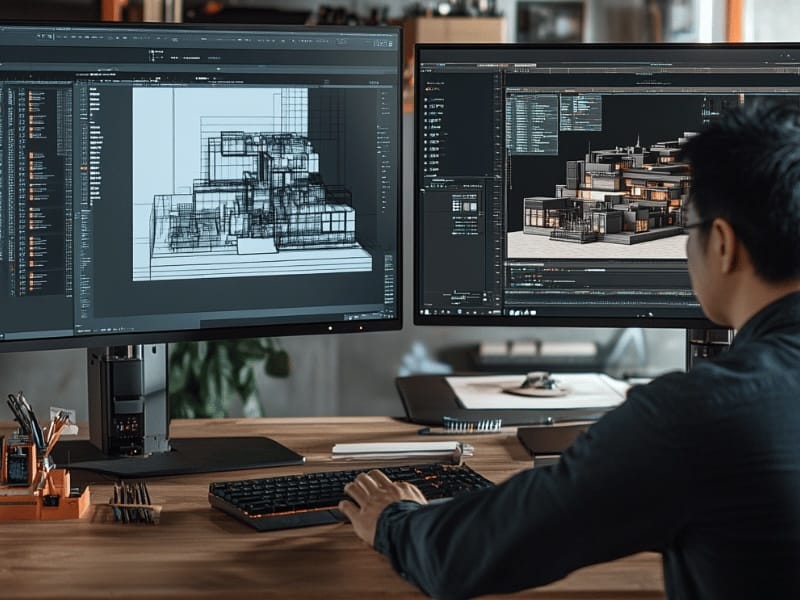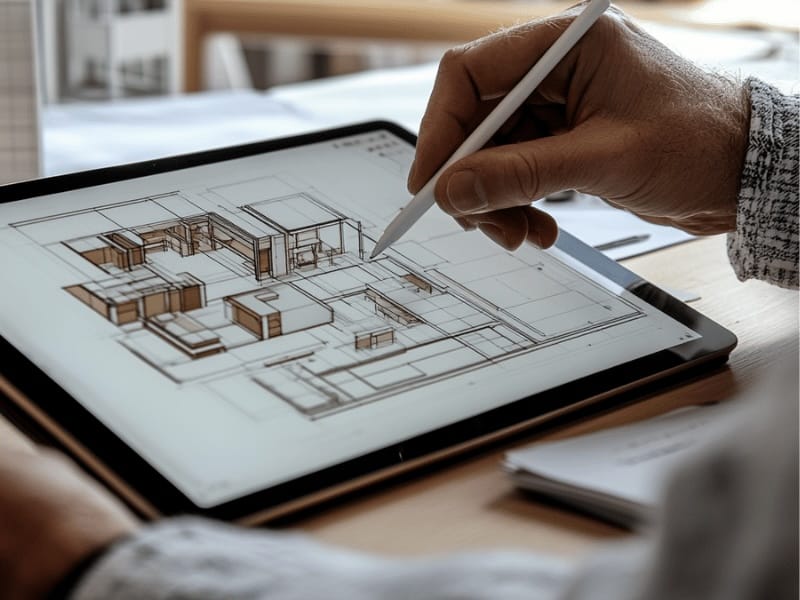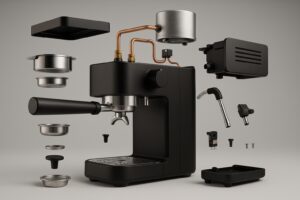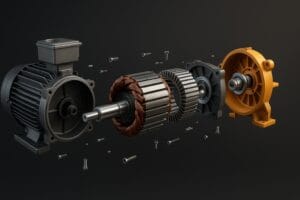In the ever-evolving world of workplace design, the need for speed and adaptability is more critical than ever. Office furniture manufacturers and designers are constantly challenged to stay ahead of fast-moving trends and ever-changing client demands. The traditional methods of designing and prototyping furniture are not just costly but also time-consuming, often lagging behind the pace of modern business needs. Enter the transformative power of 3D office furniture renderings a cutting-edge solution that accelerates the design process from concept to client approval with unprecedented efficiency.
Key Takeaways
- Enhanced Visualization: 3D rendering allows for precise and adaptable visualizations, significantly improving client comprehension and interaction.
- Cost Efficiency: Reduces costs by minimizing the need for physical prototypes and identifying design flaws early, preventing expensive corrections after production.
- Accelerated Approval Process: Streamlines client feedback and approval, speeding up the time to market for new designs.
- Customization at Scale: Offers the ability to easily customize designs and experiment with different aesthetics and functionalities without substantial cost implications.
- Investment in Innovation: Utilizing advanced 3D rendering techniques positions companies at the forefront of technological integration in office furniture design, enhancing competitiveness.
The High Costs and Complexities of Traditional Office Furniture Design

Traditionally, the journey from sketchpad to showroom has been fraught with high expenses and logistical headaches. Each new design typically requires a physical prototype, which means significant material costs and extensive man-hours spent crafting and refining each piece. Materials such as wood, metal, and upholstery not only contribute to the cost but also require precise handling and craftsmanship to achieve the desired aesthetic and functional outcomes. These material costs escalate further with each iteration needed for adjustments or improvements.
Ergonomic and Functional Requirements
Office furniture must not only be aesthetically pleasing but also ergonomic, functional, and adaptable to various office environments—each requirement adding layers of complexity to the design process. Ensuring that furniture meets ergonomic standards involves rigorous testing and modification, which is both time-consuming and costly. Functional requirements like adjustability, durability, and user comfort add additional layers of testing and prototyping to ensure the final product is fit for purpose.
Logistical Challenges and Time Constraints
The old-school approach often creates a bottleneck in innovation, with each iteration or modification requiring a new prototype. This process involves not just the physical creation of prototypes but also their transportation, assembly, and evaluation in real-world settings. Such delays can be costly, not just in terms of production expenses but also in lost opportunities as designers struggle to keep pace with market trends and client expectations. The time taken to produce and ship prototypes can significantly extend project timelines, making it difficult to respond swiftly to market demands.
Innovation Bottlenecks
With each new design requiring a physical prototype, the pace of innovation is inherently slow. Designers are constrained by the time and cost associated with producing and evaluating each iteration. This bottleneck often results in fewer design cycles, limiting the ability to explore a wide range of creative solutions. As a result, companies may miss out on innovative designs that could have been realized with more flexible and efficient processes.
Competitive Disadvantages
In the fast-paced world of office furniture design, delays in bringing new products to market can result in significant competitive disadvantages. Companies that rely solely on traditional methods may find themselves outpaced by competitors who adopt more agile and cost-effective approaches, such as 3D rendering and virtual prototyping. This competitive lag not only affects market share but also impacts the company’s reputation as an innovator in the industry.
Environmental Impact
Traditional prototyping methods also have a considerable environmental impact. The production of physical prototypes often leads to material waste, especially when multiple iterations are discarded. This not only increases costs but also contributes to the environmental footprint of the manufacturing process. By reducing the need for physical prototypes, companies can significantly decrease their waste and promote more sustainable practices in furniture design.
Streamlining Design Processes with 3D Furniture Renderings

3D rendering technology revolutionizes this traditional process by allowing designers to explore, modify, and perfect their creations in a virtual environment. With 3D renderings, office furniture designers can quickly visualize how a new chair or desk will look and function within a variety of virtual office settings. This not only speeds up the design iteration process but also enables designers to experiment with different aesthetics and configurations without the cost of physical prototypes.
These virtual models are incredibly versatile, capable of simulating real-world use and wear, which helps in assessing the durability and functionality of a design before it ever enters production. By adopting 3D renderings, designers are not just saving time and resources; they are also gaining the ability to conduct thorough pre-market testing and refinement that traditional methods would not feasibly allow.
Accelerating Approval and Time to Market

One of the most significant advantages of 3D renderings lies in their ability to streamline client communications. Instead of waiting weeks for a prototype to be built and reviewed, designers can now present realistic, detailed models of furniture within days—or even hours—of completing the design. This rapid turnaround dramatically reduces the cycle time for feedback and revisions, crucial for staying on schedule with project timelines and for keeping clients engaged and satisfied throughout the design process.
Moreover, 3D renderings allow for the presentation of multiple design options, from various angles and in different environments, at virtually no additional cost. Clients can see and approve not just the furniture but the context in which it will be used, which helps in making more informed decisions quickly, thus speeding up the time to market.
Financial Advantages of 3D Office Furniture Renderings

The adoption of 3D rendering brings with it a plethora of financial benefits for office furniture manufacturers and designers. The most direct advantage is the dramatic reduction in the cost of physical prototypes. By transitioning much of the pre-production design process to a virtual environment, companies can save on the materials and labor traditionally required to produce multiple prototypes for testing and client approvals. This not only cuts down on initial expenses but also reduces the waste associated with producing prototypes that may never be used.
Moreover, the precision of 3D renderings helps in identifying and correcting potential design flaws early in the development process. This proactive approach to quality assurance minimizes costly errors that might only be discovered during physical production or, worse, post-sale. The ability to fine-tune designs in the virtual stage means that the final products are more likely to meet both the designer’s vision and the client’s expectations without the need for expensive post-production modifications.
Transforming Office Furniture Design with 3D Rendering

As we delve deeper into the transformative impact of 3D rendering on office furniture design, it becomes clear that this technology is not merely a tool for visualization but a strategic asset that aligns perfectly with the needs of modern office layouts and demanding client presentations. For manufacturers and designers, investing in high-quality 3D rendering services isn’t just about keeping up with technological trends—it’s about taking the lead in a competitive industry.
Our 3D office furniture rendering services offer a strategic advantage, allowing you to not only meet but exceed client expectations with stunning, easily adjustable, and quickly produced visual representations. With our advanced rendering capabilities, you can showcase your designs in the best possible light, ensuring that every pitch or proposal is both impressive and persuasive.
Customized Solutions for Every Client
We understand that each project is unique. Our team of skilled designers tailors each rendering to fit your specific needs, providing a personalized touch that highlights the unique aspects of your office furniture designs. Whether you’re presenting a single piece or an entire office layout, our renderings make your vision clear and compelling.
Fast and Efficient Turnaround
Time is of the essence in the competitive world of office furniture design. Our streamlined processes ensure that you receive high-quality renderings quickly, allowing you to move from concept to client presentation without delay. This efficiency not only saves you time but also reduces costs associated with prolonged design phases.
Boost Your Market Presence
Embrace the power of 3D rendering to elevate your marketing and sales strategies. High-quality visual representations of your products enhance your marketing materials, from brochures to online listings, making them more attractive to potential buyers. This not only boosts your brand’s image but also increases your market presence and reach.
Stay Ahead with Innovation
By integrating our 3D product rendering services, you position your company at the forefront of technological innovation in the office furniture industry. This not only demonstrates your commitment to quality and efficiency but also sets you apart from competitors who may still rely on traditional design methods.
Conclusion
The evolution of automotive design through the integration of 3D rendering technology marks a significant milestone in the industry. This technology is revolutionizing the way cars are designed, developed, and marketed, providing numerous benefits that were previously unimaginable. From accelerating the design process and reducing costs to enhancing creativity and improving marketing efforts, 3D rendering is reshaping the automotive landscape.
By leveraging advanced tools and techniques such as CG backgrounds, HDRi maps, and virtual production, automotive companies can produce stunning, photorealistic visuals that captivate and engage their audience. This not only allows for more efficient and cost-effective product development but also ensures that marketing materials are both current and compelling.
As the industry continues to embrace these innovations, the future of automotive design looks brighter than ever. The adoption of 3D rendering technology is not just a trend but a fundamental shift that promises to drive further advancements and set new standards in the field. For decision-makers in the automotive industry, understanding and implementing these technologies is crucial to staying competitive and delivering products that meet the highest standards of quality and innovation.
By embracing 3D rendering, automotive companies can stay ahead of the curve, bringing products to market faster, reducing environmental impact, and delivering groundbreaking designs that resonate with consumers. The journey of automotive design is evolving, and those who adapt will lead the way into a new era of innovation and excellence.
Ready to Transform Your Office Furniture Design Process?
Discover the power of 3D rendering to revolutionize your designs and delight your clients. Contact us today for a demo and see what 3D Product rendering can do for you.
FAQs
Initial costs can include software acquisition, training for designers, and possibly hardware upgrades. However, these are often offset by the savings from reduced prototype production.
Most businesses observe a return on investment within the first few projects as the savings from reduced prototyping and error rates quickly accumulate.
Absolutely. 3D rendering is ideal for custom designs as it allows for high flexibility in adjustments and client approvals without the need for costly physical samples.
- Designers typically need some training in specific 3D modeling software, which can range from a few days to a few weeks, depending on their prior experience with similar tools.










